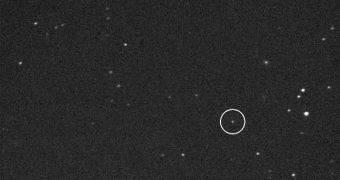An asteroid that astronomers discovered earlier this year is apparently winking at observers once every four minutes or so, according to experts who surveyed the space rock. The object, called 2011 GP59, goes dark, and then becomes bright again, at regular intervals.
Experts say that this type of blinking behavior is usually visible in asteroids that are very elongated. The shape makes their profile very small at certain points during the spin, especially when viewed along their long axis.
It's all in the angle at which light falls on the rotating space rock, astronomers add. “Usually, when we see an asteroid strobe on and off like that, it means that the body is elongated and we are viewing it broadside along its long axis first, and then on its narrow end as it rotates,” explains Don Yeomans.
“GP59 is approximately 50 meters [240 feet] long, and we think its period of rotation is about seven-and-a-half minutes. This makes the object's brightness change every four minutes or so,” he adds.
Yeomans holds an appointment as the manager of the NASA Near-Earth Object Program Office, at the Pasadena, California-based Jet Propulsion Laboratory (JPL). The facility is managed by the California Institute of Technology (Caltech) for the NASA Science Mission Directorate, in Washington DC.
The first video of 2011 GP59 was captured by an amateur astronomer from Essex, England. Nick James was conducting a survey of the sky on the night of April 11, when he saw the interesting asteroid. He used an 11-inch Schmidt-Cassegrain telescope for the job.
The amateur astronomer captured 137 individual frames of the object, each of which required 30 seconds of exposure. The photos were then compiled into a short clip depicting the object's “wink.”
When the study was conducted, the asteroid was flying through the inner solar system, some 3,356,000 kilometers (2,081,000 mile) away from Earth. In the last four days, numerous astronomers have taken an interest in the object, which now has several other short clips as well.
“Although newly discovered, the near-term orbital location of asteroid 2011 GP59 can be accurately plotted.. There is no possibility of the small space rock entering Earth's atmosphere during this pass or for the foreseeable future,” Yeomans explains.
The asteroid 2011 GP59 was discovered by a team of astronomers at the Observatorio Astronomico de Mallorca in Andalusia, Spain. This happened on the night of April 8. Since then, experts determined that the object's closest approach to Earth will take place today, April 15, at 19:09 UTC.

 14 DAY TRIAL //
14 DAY TRIAL //